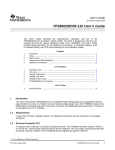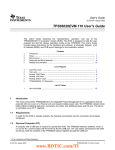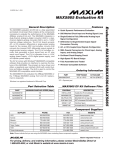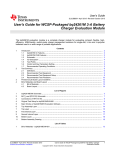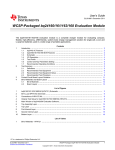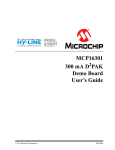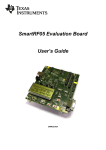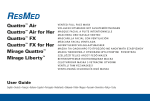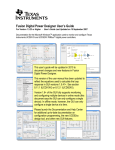Download Texas Instruments TPS65023B User's Manual
Transcript
User's Guide SLVU394 – October 2010 TPS65023B/TPS650231EVM The characteristics, operation, and use of the TPS65023B/TPS650231EVM-664 evaluation module (EVM) are described in this document. This EVM is designed to help the user evaluate and test the various operating modes of the TPS65023B/TPS650231. This user’s guide includes setup instructions for the hardware and software, a schematic diagram, a bill of materials, and PCB layout drawings for the evaluation module. 1 2 3 4 5 Contents Introduction .................................................................................................................. 1 Electrical Performance Specification ..................................................................................... 2 Input/Output Connector Description ...................................................................................... 3 Board Layout ................................................................................................................ 6 Schematic and Bill of Materials .......................................................................................... 11 List of Figures 1 Assembly Layer ............................................................................................................. 6 2 Top Layer Routing .......................................................................................................... 7 3 Layer-2 Routing, GND Plane .............................................................................................. 8 4 Layer-3 Routing, Vin Plane ................................................................................................ 9 5 Bottom Layer Routing ..................................................................................................... 10 6 TPS65023B/TPS650231EVM-664 Schematic ......................................................................... 11 1 EVM Ordering Options ..................................................................................................... 2 2 Default LDO Output Voltages TPS65023B .............................................................................. 2 3 Default LDO Output Voltages TPS650231 .............................................................................. 2 4 TPS65023B/TPS650231EVM-664 Bill of Materials ................................................................... 12 List of Tables 1 Introduction The Texas Instruments TPS65023B/TPS650231EVM is an integrated power management integrated circuit (IC) for applications that are powered with one Li-ion or Li-polymer cell and require multiple power rails. The TPS65023B/TPS650231 contains three highly efficient switching step-down converters, two LDOs, and additional status and I/O pins. The device is controlled via an I2C interface (HPA172). 1.1 Requirements In order for this EVM to operate properly, the following components must be connected and properly configured. 1.1.1 Personal Computer A personal computer with a USB port is required to operate this EVM. The TPS65023B/TPS650231 interface software, which is run on the personal computer (PC), communicates with the EVM via the PC USB port. The user sends commands to the EVM as well as reads the contents of the TPS65023B/TPS650231 internal registers through the USB port. SLVU394 – October 2010 Submit Documentation Feedback TPS65023B/TPS650231EVM Copyright © 2010, Texas Instruments Incorporated 1 Electrical Performance Specification 1.1.2 www.ti.com Printed-Circuit Board Assembly The TPS65023B/TPS650231EVM-664 PCB contains the TPS65023B/TPS650231 IC and its required external components. This board contains several jumpers and connectors that allow the user to customize the board for specific operating conditions. USB-to- I 2C Adapter 1.1.3 The USB-to-I2C Adapter, also known as the HPA172, is the link that allows the PC and the EVM to communicate. The adapter connects to the PC with the supplied USB cable on one side and to the EVM though the supplied ribbon cable on the other. When the user writes a command to the EVM, the interface program, which is run from the PC, sends the command to the PC USB port. The adapter receives the USB command and converts the signal to an I2C protocol. It then sends the I2C signal to the TPS65023B/TPS650231 board. When the user reads a status register from the EVM, the PC sends a command to read a register on the EVM. When the EVM receives the command, it reports the status of the register via the I2C interface. The adapter receives the information on the I2C interface, converts it to a USB protocol, and sends it to the PC. 1.1.4 Software Texas Instruments provides software to assist the user in evaluating this EVM. To install the software, go to the Texas Instruments Web page and download the latest software version from the TPS65023B or TPS650231 product folder. Once you have downloaded the software, execute the setup file, and follow the instructions given. 1.2 Features • • • • • 2 Three high-efficiency DC/DC step-down converters (1.7 A/1.2 A/1 A) 2 x 200-mA low-dropout (LDO) regulators 30-mA RTC (Reel Time Clock) LDO I2C Interface (100-ns setup and hold time) Dynamic voltage scaling DCDC1 Electrical Performance Specification Table 1. EVM Ordering Options Default Output Voltages Orderable EVM Number Device Part Number DCDC1 DCDC2 DCDC3 LDO1 LDO2 TPS65023BEVM-664 TPS65023B 1.2V / 1.6V 1/8V / 3.3V 1.8V / 3.3V SeeTable 2 SeeTable 2 TPS650231EVM-664 TPS650231 1.2V / 1.6V n/a 1.8V / 3.3V See Table 3 See Table 3 Table 2. Default LDO Output Voltages TPS65023B DEFLDO2 DEFLDO1 VLDO1 VLDO2 0 0 1.3 V 3.3 V 0 1 2.8 V 3.3 V 1 0 1.3 V 1.8 V 1 1 1.8 V 3.3 V Table 3. Default LDO Output Voltages TPS650231 2 DEFLDO2 DEFLDO1 VLDO1 VLDO2 0 0 1.3 V 3.3 V 0 1 2.8 V 3.3 V 1 0 1.3 V 1.8 V 1 1 2.1 V 3.3 V TPS65023B/TPS650231EVM SLVU394 – October 2010 Submit Documentation Feedback Copyright © 2010, Texas Instruments Incorporated Input/Output Connector Description www.ti.com 3 Input/Output Connector Description This section describes the jumpers and connectors on the EVM, as well as how to properly connect, set up, and use the TPS65023B/TPS650231EVM-664. J1 – VIN Input voltage from external power supply, recommended maximum 5.5 V. Input current depends on load but typically is less than 2 A. J2 – GND This is the return connection for VIN. J3 – VINLDO/GND Input voltage and return for LDO1 and LDO2. Resistor R20 connects this pin to VIN. If an external power supply is used, remove R20. Recommended maximum input voltage is 5.5 V. J4 – VSYSIN/GND Input voltage and return for VSYSIN, one of the input voltages for RTC. Resistor R21 can be used to connect this input to VIN. If an external power supply is used, remove R21. Recommended maximum input voltage is 4 V. J5 – VBACKUP/GND Input voltage and return for VBACKUP, one of the input voltages for RTC. There are no onboard connections to a voltage input. Recommended maximum input voltage is 4 V. J6 – VRTC/GND Output voltage from RTC circuit. J7 – Fault Outputs Four fault outputs are available on this connector: PWRFAIL – Fault occurs when input voltage is less than 3 V. Pulled up to VRTC when safe; low for fail. INT – Fault occurs when a fail is on an input or output voltage; acts as a sum fail. Pulled up to VIN when safe; low for fail. RESPWRON – Low reset signal is controlled by SW1, 144 ms. Pulled up to VIN normally. LOWBAT – Fault occurs when input voltage is less than 3.6 V. Pulled up to VIN when safe; low for fail. J8 – I2C This header duplicates the I2C signals from the J20 interface connector. I2C data (SDA) and clock (SCL) can be accessed on this header J9 – VDCDC1 Output from DCDC1 switching regulator maximum output current 1.7 A; default voltage setting is 3.3 V. J10 – GND Return for VDCDC1. J11 – VDCDC2 Output from DCDC2 switching regulator; maximum output current 1.2 A. J12 – GND Return for VDCDC2 J13 – VLDO1 Output from low-dropout regulator VLDO1; maximum output current 200 mA. J14 – GND Return for VLDO1 J15 – VLDO2 Output from low-dropout regulator VLDO2; maximum output current 200 mA. J16 – GND Return for VLDO2. SLVU394 – October 2010 Submit Documentation Feedback TPS65023B/TPS650231EVM Copyright © 2010, Texas Instruments Incorporated 3 Input/Output Connector Description www.ti.com J17 – VDCDC3 Output from switching regulator DCDC3; maximum output current 1 A. J18– GND Return for VDCDC3. J19 – J19 is the interface connector for the I2C interface. Connect a 10-pin ribbon cable between J13 and the USB-to-GPIO interface. JP1 – DEF1 Sets default voltage for DCDC1, 1.2 V or 1.6 V. JP2 – DEF2 Sets default voltage for DCDC2, 3.3 V or 1.8 V, in TPS65023B (HPA664-001) configuration. In the TPS650231, no default output voltage options are available. In this case, the output voltage is adjustable with an external voltage divider R3, R2. The default setup is 1.2 V in the factory EVM (HPA664-002) configuration. See section x for advanced voltage scaling options.. JP3 – DEF3 Sets default voltage for DCDC3, 3.3 V or 1.8 V. JP4 – DCDC1 ON/OFF EN for DCDC1 converter; default setting is ON JP5 – DCDC2 ON/OFF EN for DCDC2 converter; default setting is ON. JP6 – DCDC3 ON/OFF EN for DCDC3 converter; default setting is ON. JP7 – LDO ON/OFF EN for both LDO1 and LDO2 regulators; default setting is ON. JP8 – DEFLDO1 Sets default voltage for LDO1 and LDO2 in combination with DEFLDO2. (See Table 2 for TPS65023B and Table 3 for TPS650231 - defaults LDO output voltages.) JP9 – DEFLDO2 Sets default voltage for LDO1 and LDO2 in combination with DEFLDO1. (See Table 2 for TPS65023B and Table 3 for TPS650231 - defaults LDO output voltages.) S1 – HOT_RST S1 is a normally open, momentary pushbutton switch that, when pressed, connects the HOT_RST input of the TPS650231 to GND, generating the HOT_RESET pulse. HOT_RESET pin is pulled up externally. 3.1 Setup The following steps must be followed before the EVM can be operated. 1. Install the TPS65023B/TPS650231EVM software. 2. Connect input voltages and loads to the EVM. 3. Configure all EVM jumpers to factory setting. JP4–ON JP2–1.8V JP7–ON 4 JP1–1.6V JP5–ON JP9–High JP3–1.8V JP6–ON JP8–High TPS65023B/TPS650231EVM SLVU394 – October 2010 Submit Documentation Feedback Copyright © 2010, Texas Instruments Incorporated Input/Output Connector Description www.ti.com 4. 5. 6. 7. 3.2 3.2.1 Connect the ribbon cable between the EVM and the USB-TO-GPIO (HPA172) adapter. Connect the USB cable between the computer and the HPA172EVM. Turn on all supplies. Run the TPS65023B/TPS650231EVM software Modifications Setting the Output Voltage The TPS65023B features two default output voltages. These output voltages can be selected by pulling DEFDCDC2 high – selecting the higher default output voltage – or pulling DEFDCDC2 low – selecting the lower default output voltage. In addition, the output voltage of DCDC2 can be externally adjusted with the resistor divider network R3 and R6. The default configuration of the TPS65023BEVM-664 is that R3 and R6 are not assembled. The default output voltage of DCDC2 can be selected with JP2. Note that the default output voltage is selected once at startup of the device. Changing logic level of DEFDCDC2 during operation does not affect the output voltage and is not allowed. 3.2.2 Setting the Output Voltage for DCDC2, TPS650231 The TPS650231 does not feature these default output voltages. The output voltages of DCDC2 is externally adjustable only. The default configuration of the TPS650231EVM-664 is that R3 and R6 are not assembled. JP2 is not assembled. TPS650231 does not have the default output voltage feature, and this provides the benefit of external voltage scaling options. 3.2.3 Simple Two-Point Voltage Scaling, TPS650231 DCDC2 does not have the previously described preset default output voltages. An external voltage scaling circuit is on the EVM, and the output voltage of DCDC2 can be switched between two preset voltages. This useful feature reduces the power consumption of an application processor in Low Power mode. The voltage scaling circuit consists of JP2,Q1, R3, R6, and R24. The circuit uses a transistor (Q1) to connect a resistor (R24) in parallel to the lower resistor of the feedback network (R6) of DCDC2. Modifying the resistor network by paralleling R24 and R6 reduces the overall resistance of the lower resistor and therefore increases the output voltage of the DC/DC converter. See Equation 1 and Equation 2 to design R24. In the factory configuration, the components JP2, Q1, and R24 are not assembled on the board. 3.2.4 Scaling the Output Voltage of DCDC2 From LDO2 Another approach to scale the DC/DC converter output voltage is to use an external adjustable voltage. Any external adjustable voltage source can be used, e.g., output voltage of an digital-to-analog converter. In the TPS65023B/TPS650231, LDO1 and LDO2 can be adjusted via I2C. The TPS65023B/TPS650231 provides the ability to feed the output voltage of LDO2 back to the resistor divider network, using R25, and therefore scale the output voltage of DCDC2 based on the LDO2 output voltage. In this configuration, R25, R3, and R6 need to be assembled. R24, R26, Q1, and R3 need to be removed. Vout _ DCDC2 = V _ REF ´ (1 + R1 R1 )) + ( V _ REF - VLDO2) ´ ( ) R3 R2 (1) From Equation 2 it can be seen that maximum DCDC1 output voltage occurs for minimum VLDO2, and minimum DCDC1 output voltage occurs for maximum VLDO2. To ensure that the desired DCDC1 output voltages can be adjusted, design the resistors R25, R3, and R6 according to and Equation 2 and Equation 2. SLVU394 – October 2010 Submit Documentation Feedback TPS65023B/TPS650231EVM Copyright © 2010, Texas Instruments Incorporated 5 Board Layout www.ti.com Vout _ DCDC2, min = V _ REF ´ (1 + R1 R1 )) + ( V _ REF - VLDO2, max) ´ ( ) R3 R2 (2) Vout _ DCDC2, max = V _ REF ´ (1 + R1 R1 )) + ( V _ REF - VLDO2, min) ´ ( ) R3 R2 (3) The most straight forward way is to choose a value for R6 according to the recommendations in the converter data sheet. 4 Board Layout This section provides the TPS65023B/TPS650231EVM-664 board layout and illustrations. 4.1 Layout Board layout is critical for all switch mode power supplies. Figure 1 through Figure 5 show the board layout for the TPS65023B/TPS650231EVM-664 PCB. The nodes with high switching frequencies and currents are short and are isolated from the noise-sensitive feedback circuitry. Careful attention has been given to the routing of high-frequency current loops. See the data sheet for specific layout guidelines. Figure 1. Assembly Layer 6 TPS65023B/TPS650231EVM SLVU394 – October 2010 Submit Documentation Feedback Copyright © 2010, Texas Instruments Incorporated Board Layout www.ti.com Figure 2. Top Layer Routing SLVU394 – October 2010 Submit Documentation Feedback TPS65023B/TPS650231EVM Copyright © 2010, Texas Instruments Incorporated 7 Board Layout www.ti.com Figure 3. Layer-2 Routing, GND Plane 8 TPS65023B/TPS650231EVM SLVU394 – October 2010 Submit Documentation Feedback Copyright © 2010, Texas Instruments Incorporated Board Layout www.ti.com Figure 4. Layer-3 Routing, Vin Plane SLVU394 – October 2010 Submit Documentation Feedback TPS65023B/TPS650231EVM Copyright © 2010, Texas Instruments Incorporated 9 Board Layout www.ti.com Figure 5. Bottom Layer Routing 10 TPS65023B/TPS650231EVM SLVU394 – October 2010 Submit Documentation Feedback Copyright © 2010, Texas Instruments Incorporated Schematic and Bill of Materials www.ti.com 5 Schematic and Bill of Materials This section provides the TPS65023B/TPS650231EVM-664 schematic and bill of materials. 5.1 Schematic Figure 6. TPS65023B/TPS650231EVM-664 Schematic SLVU394 – October 2010 Submit Documentation Feedback TPS65023B/TPS650231EVM Copyright © 2010, Texas Instruments Incorporated 11 Schematic and Bill of Materials 5.2 www.ti.com Bill of Materials Table 4. TPS65023B/TPS650231EVM-664 Bill of Materials Count RefDes Value Description Size Part Number 9 C1, C2, C4, C9, C10, C11, C14–C16 10 µF Capacitor, Ceramic, 6.3V, X5R, 10% 0805 Std 4 4 C3, C6, C7, C17 1.0 µF Capacitor, Ceramic, 6.3V, X5R,10% 0603 Std 1 1 C5 1500 pF Capacitor, Ceramic, 50V, X7R, 10% 0603 C1608X7R1H152K 4 4 C8, C18 2.2 µF Capacitor, Ceramic, 6.3V, X5R, 10% 0603 C1608X5R0J225K 3 3 L1, L2, L3 2.2 µH Inductor, SMT, 2.0A, 110mΩ 0.157 x 0.157 LPS3015-222ML 0 0 R1, R2, R4–R6, R17, R18, R21 Open Resistor, Chip, 1/16W, 1% 0603 Std 0 1 R3 182k Resistor, Chip, 1/16W, 1% 0603 Std 0 1 R6 365k Resistor, Chip, 1/16W, 1% 0603 Std 6 6 R7, R11–R14, R22 100k Resistor, Chip, 1/16W, 1% 0603 Std 1 1 R8 10 Resistor, Chip, 1/16W, 1% 0603 Std 1 1 R9 1.20M Resistor, Chip, 1/16W, 1% 0603 Std 1 1 R10 499k Resistor, Chip, 1/16W, 1% 0603 Std 2 2 R15, R16 4.75k Resistor, Chip, 1/16W, 1% 0603 Std 2 2 R19, R20 0 Resistor, Chip, 1/16W, 5% 0603 Std 1 0 U1 TPS65023BRSB IC, Power Management IC for Li-Ion Powered Systems QFN TPS65023BRSB 0 1 U1 TPS650231RSB IC, Power Management IC for Li-Ion Powered Systems QFN TPS650231RSB -001 -002 9 5.3 Related Documentation TPS650231, Power Management IC For Li-Ion Powered Systems data sheet (SLVSAE3) 12 TPS65023B/TPS650231EVM SLVU394 – October 2010 Submit Documentation Feedback Copyright © 2010, Texas Instruments Incorporated Evaluation Board/Kit Important Notice Texas Instruments (TI) provides the enclosed product(s) under the following conditions: This evaluation board/kit is intended for use for ENGINEERING DEVELOPMENT, DEMONSTRATION, OR EVALUATION PURPOSES ONLY and is not considered by TI to be a finished end-product fit for general consumer use. Persons handling the product(s) must have electronics training and observe good engineering practice standards. As such, the goods being provided are not intended to be complete in terms of required design-, marketing-, and/or manufacturing-related protective considerations, including product safety and environmental measures typically found in end products that incorporate such semiconductor components or circuit boards. This evaluation board/kit does not fall within the scope of the European Union directives regarding electromagnetic compatibility, restricted substances (RoHS), recycling (WEEE), FCC, CE or UL, and therefore may not meet the technical requirements of these directives or other related directives. Should this evaluation board/kit not meet the specifications indicated in the User’s Guide, the board/kit may be returned within 30 days from the date of delivery for a full refund. THE FOREGOING WARRANTY IS THE EXCLUSIVE WARRANTY MADE BY SELLER TO BUYER AND IS IN LIEU OF ALL OTHER WARRANTIES, EXPRESSED, IMPLIED, OR STATUTORY, INCLUDING ANY WARRANTY OF MERCHANTABILITY OR FITNESS FOR ANY PARTICULAR PURPOSE. The user assumes all responsibility and liability for proper and safe handling of the goods. Further, the user indemnifies TI from all claims arising from the handling or use of the goods. Due to the open construction of the product, it is the user’s responsibility to take any and all appropriate precautions with regard to electrostatic discharge. EXCEPT TO THE EXTENT OF THE INDEMNITY SET FORTH ABOVE, NEITHER PARTY SHALL BE LIABLE TO THE OTHER FOR ANY INDIRECT, SPECIAL, INCIDENTAL, OR CONSEQUENTIAL DAMAGES. TI currently deals with a variety of customers for products, and therefore our arrangement with the user is not exclusive. TI assumes no liability for applications assistance, customer product design, software performance, or infringement of patents or services described herein. Please read the User’s Guide and, specifically, the Warnings and Restrictions notice in the User’s Guide prior to handling the product. This notice contains important safety information about temperatures and voltages. For additional information on TI’s environmental and/or safety programs, please contact the TI application engineer or visit www.ti.com/esh. No license is granted under any patent right or other intellectual property right of TI covering or relating to any machine, process, or combination in which such TI products or services might be or are used. FCC Warning This evaluation board/kit is intended for use for ENGINEERING DEVELOPMENT, DEMONSTRATION, OR EVALUATION PURPOSES ONLY and is not considered by TI to be a finished end-product fit for general consumer use. It generates, uses, and can radiate radio frequency energy and has not been tested for compliance with the limits of computing devices pursuant to part 15 of FCC rules, which are designed to provide reasonable protection against radio frequency interference. Operation of this equipment in other environments may cause interference with radio communications, in which case the user at his own expense will be required to take whatever measures may be required to correct this interference. EVM Warnings and Restrictions It is important to operate this EVM within the input voltage range of 3.3 V to 5.5 V and the output voltage range of 0.8 V to 3.3 V . Exceeding the specified input range may cause unexpected operation and/or irreversible damage to the EVM. If there are questions concerning the input range, please contact a TI field representative prior to connecting the input power. Applying loads outside of the specified output range may result in unintended operation and/or possible permanent damage to the EVM. Please consult the EVM User's Guide prior to connecting any load to the EVM output. If there is uncertainty as to the load specification, please contact a TI field representative. During normal operation, some circuit components may have case temperatures greater than 60°C. The EVM is designed to operate properly with certain components above 60°C as long as the input and output ranges are maintained. These components include but are not limited to linear regulators, switching transistors, pass transistors, and current sense resistors. These types of devices can be identified using the EVM schematic located in the EVM User's Guide. When placing measurement probes near these devices during operation, please be aware that these devices may be very warm to the touch. Mailing Address: Texas Instruments, Post Office Box 655303, Dallas, Texas 75265 Copyright © 2010, Texas Instruments Incorporated IMPORTANT NOTICE Texas Instruments Incorporated and its subsidiaries (TI) reserve the right to make corrections, modifications, enhancements, improvements, and other changes to its products and services at any time and to discontinue any product or service without notice. Customers should obtain the latest relevant information before placing orders and should verify that such information is current and complete. All products are sold subject to TI’s terms and conditions of sale supplied at the time of order acknowledgment. TI warrants performance of its hardware products to the specifications applicable at the time of sale in accordance with TI’s standard warranty. Testing and other quality control techniques are used to the extent TI deems necessary to support this warranty. Except where mandated by government requirements, testing of all parameters of each product is not necessarily performed. TI assumes no liability for applications assistance or customer product design. Customers are responsible for their products and applications using TI components. To minimize the risks associated with customer products and applications, customers should provide adequate design and operating safeguards. TI does not warrant or represent that any license, either express or implied, is granted under any TI patent right, copyright, mask work right, or other TI intellectual property right relating to any combination, machine, or process in which TI products or services are used. Information published by TI regarding third-party products or services does not constitute a license from TI to use such products or services or a warranty or endorsement thereof. Use of such information may require a license from a third party under the patents or other intellectual property of the third party, or a license from TI under the patents or other intellectual property of TI. Reproduction of TI information in TI data books or data sheets is permissible only if reproduction is without alteration and is accompanied by all associated warranties, conditions, limitations, and notices. Reproduction of this information with alteration is an unfair and deceptive business practice. TI is not responsible or liable for such altered documentation. Information of third parties may be subject to additional restrictions. Resale of TI products or services with statements different from or beyond the parameters stated by TI for that product or service voids all express and any implied warranties for the associated TI product or service and is an unfair and deceptive business practice. TI is not responsible or liable for any such statements. TI products are not authorized for use in safety-critical applications (such as life support) where a failure of the TI product would reasonably be expected to cause severe personal injury or death, unless officers of the parties have executed an agreement specifically governing such use. Buyers represent that they have all necessary expertise in the safety and regulatory ramifications of their applications, and acknowledge and agree that they are solely responsible for all legal, regulatory and safety-related requirements concerning their products and any use of TI products in such safety-critical applications, notwithstanding any applications-related information or support that may be provided by TI. Further, Buyers must fully indemnify TI and its representatives against any damages arising out of the use of TI products in such safety-critical applications. TI products are neither designed nor intended for use in military/aerospace applications or environments unless the TI products are specifically designated by TI as military-grade or "enhanced plastic." Only products designated by TI as military-grade meet military specifications. Buyers acknowledge and agree that any such use of TI products which TI has not designated as military-grade is solely at the Buyer's risk, and that they are solely responsible for compliance with all legal and regulatory requirements in connection with such use. TI products are neither designed nor intended for use in automotive applications or environments unless the specific TI products are designated by TI as compliant with ISO/TS 16949 requirements. Buyers acknowledge and agree that, if they use any non-designated products in automotive applications, TI will not be responsible for any failure to meet such requirements. Following are URLs where you can obtain information on other Texas Instruments products and application solutions: Products Applications Amplifiers amplifier.ti.com Audio www.ti.com/audio Data Converters dataconverter.ti.com Automotive www.ti.com/automotive DLP® Products www.dlp.com Communications and Telecom www.ti.com/communications DSP dsp.ti.com Computers and Peripherals www.ti.com/computers Clocks and Timers www.ti.com/clocks Consumer Electronics www.ti.com/consumer-apps Interface interface.ti.com Energy www.ti.com/energy Logic logic.ti.com Industrial www.ti.com/industrial Power Mgmt power.ti.com Medical www.ti.com/medical Microcontrollers microcontroller.ti.com Security www.ti.com/security RFID www.ti-rfid.com Space, Avionics & Defense www.ti.com/space-avionics-defense RF/IF and ZigBee® Solutions www.ti.com/lprf Video and Imaging www.ti.com/video Wireless www.ti.com/wireless-apps Mailing Address: Texas Instruments, Post Office Box 655303, Dallas, Texas 75265 Copyright © 2010, Texas Instruments Incorporated














